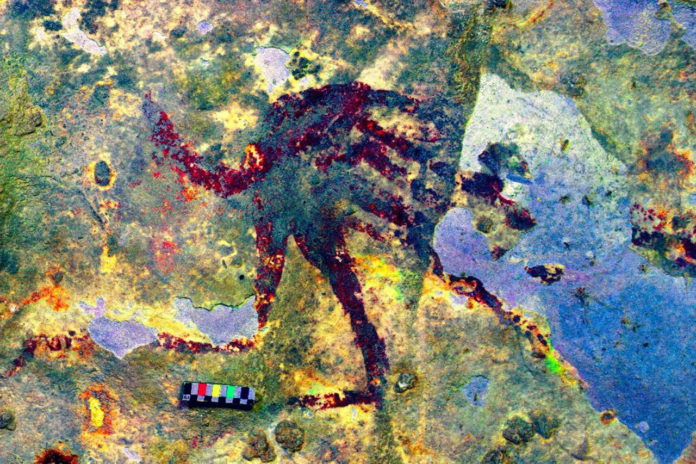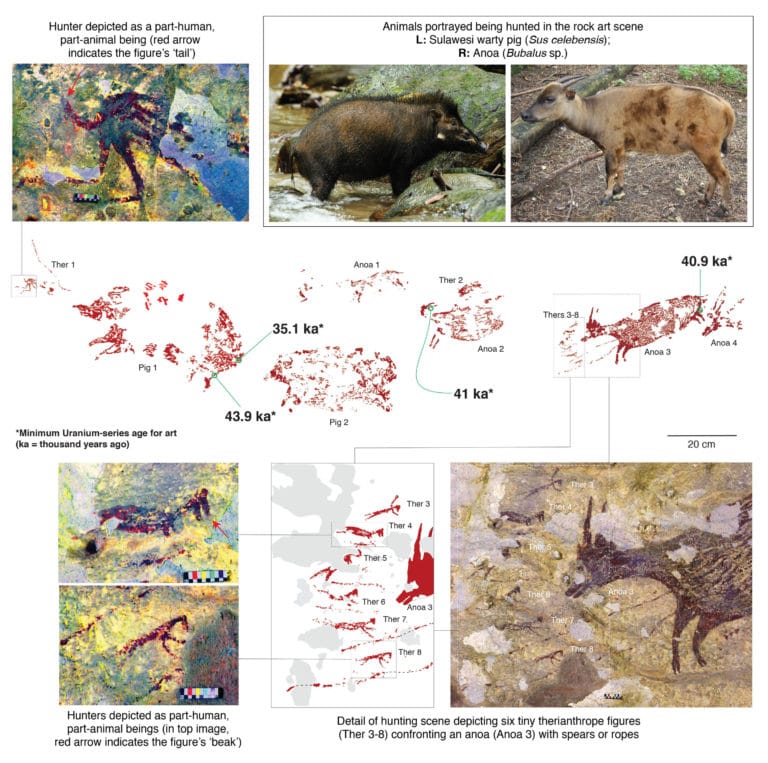Anthropology
Related: About this forumWorld's oldest figurative artwork uncovered
Discovered two years ago on the island of Sulawesi, the 4.5 metres (13 foot) wide painting features wild animals being chased by half-human hunters wielding what appear to be spears and ropes.
BY
PRANJAL MEHAR
DECEMBER 12, 2019

Cave art on the island of Sulawesi, Indonesia, was painted 44,000 years ago and is the oldest known to date
Prehistoric cave art provides the most direct insight that we have into the earliest storytelling, in the form of narrative compositions or ‘scenes that feature explicit figurative depictions of sets of figures in spatial proximity to each other, and from which one can infer actions taking place among the figures. One such art is recently uncovered in an Indonesian cave.
A new study uncovers an elaborate rock art panel from the limestone cave of Leang Bulu’ Sipong 4 (Sulawesi, Indonesia). Using dating technology, the team at Australia’s Griffith University said it had confirmed that the limestone cave painting dated back at least 44,000 years during the Upper Paleolithic period.
Discovered two years ago, the painting is 4.5 meter (13 foot) wide, and it portrays several figures that appear to represent therianthropes hunting wild pigs and dwarf bovids; this painting has been dated to at least 43.9 ka based on the uranium-series analysis of overlying speleothems.

Credit: A. Brumm (figure design and production); A.A. Oktaviana (digital tracings); R. Sardi (photographs of rock art); C.C. Lee (Sus celebensis photograph). Caption: Late Pleistocene rock art panel from Leang Bulu’ Sipong 4. Discovered in 2017, this cave painting of a narrative hunting ‘scene’ from the Indonesian island of Sulawesi has been dated using Uranium-series analysis to at least 43,900 years ago – it is the oldest known figurative art in the world.
More:
https://www.techexplorist.com/world-oldest-figurative-artwork-uncovered/28482/?utm_source=BNA&utm_medium=BNA&utm_campaign=BNA
brush
(57,614 posts)ever new in art.
wnylib
(24,419 posts)ones are at least recognizable as animals.
Before this painting was known and dated, the previously known oldest one was in Spain and a 'mere' 36,000 years old by comparison. Wonder what other ones remain to be discovered. Or, what other, older artwork might have existed but can never be found because it was made on perishable material instead of rock.
Also wonder why these paintings were made. We csn only speculate that they were for religious or hunting purposes, or maybe a combination of both. But we can't know for sure. Would be amusing if, after all our speculation, they were only meant to be home decor. Or a stone age version of an art gallery presenting the best artists of the community.
LudwigPastorius
(10,830 posts)(Also, isn't 44,000 years ago the time that Neanderthals started to go extinct? Just sayin'...)


wnylib
(24,419 posts)went extinct. The artwork is dated at 44,000 years ago. Neanderthal extinction was about 37,000 to 40, 000 years ago.
The timing for the srtwork also includes the arrival of Homo sapiens in the same region (eastern Indonesia). Homo sapiens had reached as far as Australua by 50,000 years ago.
During the period of this artwork, Homo sspiens was interbreeding with Neanderthal. In this region, Homo. sapiens was also interbreeding with Denisovans, who were distantly related to Neanderthals through a much earlier common ancestor.
So the artists who created these paintings might have been a mix of any combination of those 3. Even that long ago, as is true today, our ancestors were a mix, without 'pure' membership in a 'race,' or exclusive genetic pool.
The painting referred to as a human being has a rough resemblance to the shape of the island where the artwork exists. Was it meant to be a depiction of the land they lived on?